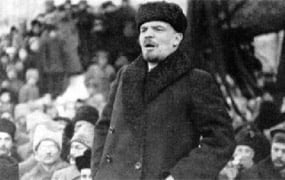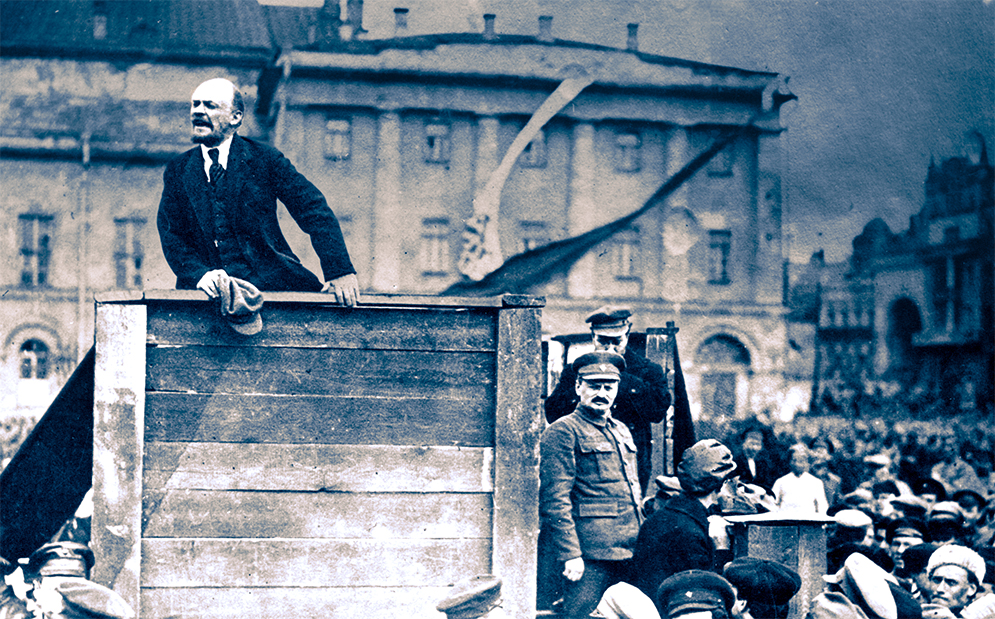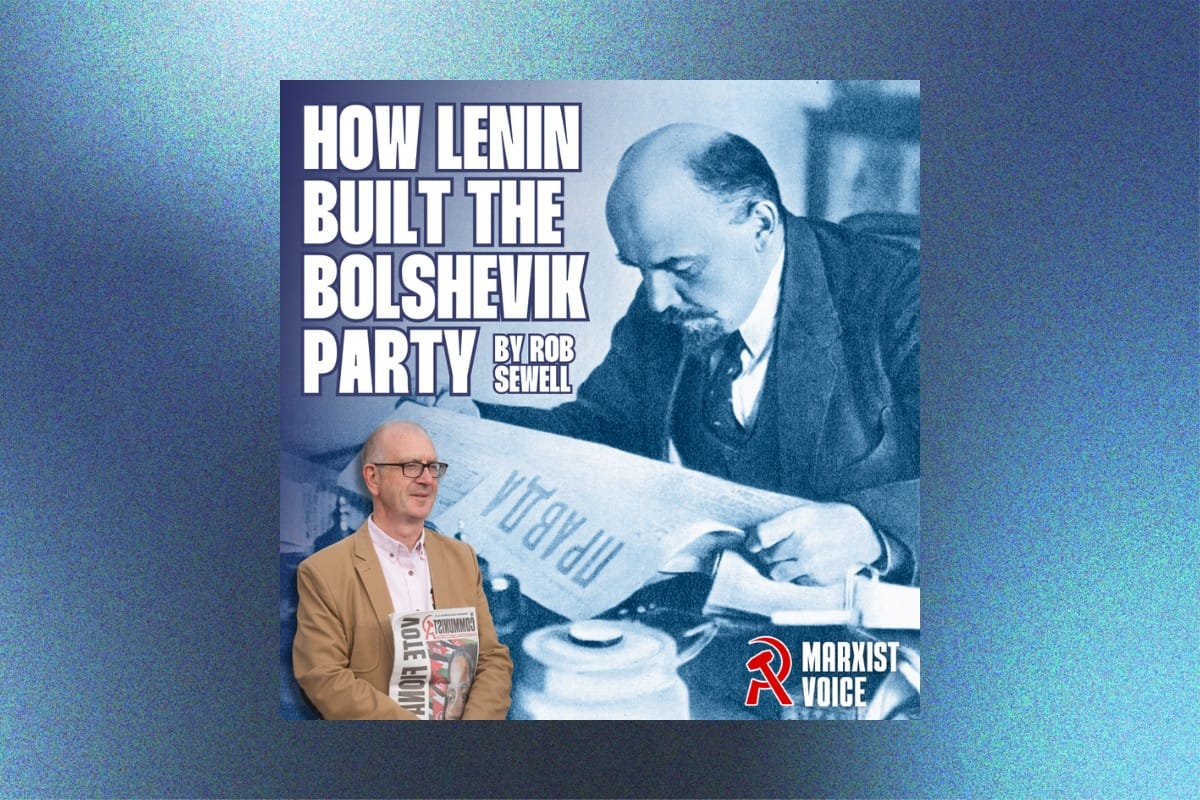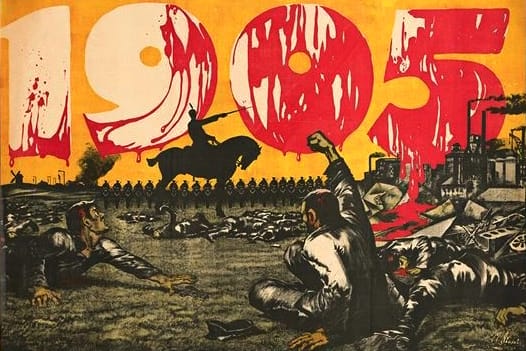"Petrograd is in an unprecedented catastrophic condition. There is no bread. The population is given the remaining potato flour and crusts. The Red Capital is on the verge of perishing from famine," stated Lenin. "The political situation has become extremely critical owing to both external and internal causes."
This view of Lenin’s summed up the horrendous plight of the Russian Revolution in May 1918, some six months after the successful Bolshevik insurrection and the introduction of Soviet rule. The "external and internal causes" which threatened the Revolution were the aggressive actions of the imperialist powers, foreign blockade, the organisation of internal counter-revolution, and the economic sabotage of the landlords and capitalists.
October Revolution
"By the end of 1918", wrote the historian E. H. Carr, "the Russian Socialist Federal Soviet Republic was confined within the same boundaries as medieval Muscovy before the conquests of Ivan the Terrible; and very few people – few perhaps even of the Bolsheviks themselves – believed that the regime could survive." The Revolution was hanging by a thread.
The October Revolution was the greatest event in human history. It swept aside the old ruling class and placed in power the workers and peasants of Russia. It began to translate the theory of socialism into reality. It became as a result a beacon and inspiration to the downtrodden masses of the world.
However, no ruling class in history has ever given up its powers and privileges without a struggle, and Russia was no exception. Although the revolution was relatively peaceful, with only five deaths in Petrograd, the capitalists internationally were determined to crush the revolution in blood. The first tasks of the Bolsheviks were therefore to implement its programme and above all organise the defence of the revolution.
War Communism
This defence of the revolution against all the ruthless attacks and sabotage of the capitalists and landlords as well as the intervention of the imperialist powers has been used by bourgeois historians to slander Lenin and the Bolsheviks. Robert Service, for instance, in his three-volume history of Lenin attacks Lenin as a "ruthless terrorist" and "power-crazy". He denounces Lenin for the "horrors which he had perpetrated between 1917 and 1922." While his ‘history’ purports to be "a balanced, multi-faceted account", his pen is dripping with spite and malice. He continues "nobody can write detachedly about Lenin. His intolerance and repressiveness continues to appal me."
No doubt, Service and our wise professors, together with the reformist apologists, wanted Lenin, Trotsky and the Bolsheviks to capitulate to the forces of the counter-revolution and renounce their socialist ‘adventure’. The Civil War is viewed by Service as a game of cricket between gentlemen, rather than a struggle between revolution (which he detests) and counter-revolution of the old order (which in effect he justifies). In this war between the classes, which is a fight to the death, ruthless measures are necessary and inevitable. It is a struggle of living forces. The young Soviet State was faced with the invasion of 21 foreign armies out to topple the regime. The Revolution was faced with internal counter-revolution which wanted to restore the old order of landlord and capitalist over the bones of the socialist republic. It was faced with an external blockade that wanted to starve the revolution to death. Under these circumstances, while waiting for help from revolutions in the west, the Soviet government had no alternative but to resist with everything at their disposal to preserve this outpost of world revolution.
Kid-gloves
In the immediate aftermath of the revolution, the counter-revolutionaries were treated with kid-gloves. The day after the revolution the death penalty was abolished. All those arrested were released as long as they gave a written promise not to engage in sabotage. Victor Serge described these liberal acts as "foolish clemency," as these individual simply gave their promise and went off to organise counter-revolution.
The counter-revolution (the ‘Whites’) attempted to smash the revolution through the organisation of open civil war as well as economic sabotage. The White Terror began in April 1918 when up to 20,000 workers were murdered in Finland by the Whites. The Civil War was a turning point. Soviet regime was forced to react. Only through resolute action would the first workers’ republic in history survive.
Lenin
As Lenin explained: "The terror was forced on us by the Terror of the Entente, the terror of mighty world imperialism,which has been throttling the workers and peasants, and is condemning them to death by starvation because they are fighting for their country’s freedom."
Blockade
The capitalist blockade had resulted in a crippling economic blow. By 1919 nothing was being imported into or exported out of Soviet Russia. This resulted in a drastic shortage of raw materials and food, resulting in starvation and collapsing productivity. Workers were struggling to work exhausted and undernourished and often collapsed. It was out of sheer fortitude and heroism towards the revolution that kept things going. The Civil War demanded the creation of a new Red Army by Trotsky. The army needed to be fed and clothed. This was to result in compulsory requisitioning of grain from the peasants as the only way to feed the towns and army. There was no alternative. There were even hunger riots in Smolensk and elsewhere. A decree was issued demanding the compulsory delivery to the state of all excess grain. This measure severely strained relations between the workers and peasants, especially the rich peasants (kulaks), who began to hide their grain.
In the worst period, bread was rationed at 1 ounce (28 grams) a day for workers. Along with famine, disease spread rapidly. Within two years, some five million people fell ill with typhus. The population of Petrograd fell from 2,400,000 in 1917 to 574,000 in August 1920. The number of industrial workers fell from 3 million in 1917 to 1 and a quarter million by 1921. At the same time, at its height the numbers of the Red Army, under Trotsky’s command, reached a staggering five million people fighting on 14 different fronts covering some 8,000 kilometres.
The October Revolution had instituted workers’ control in the factories. However, these were left in private hands until the workers had learned sufficiently how to run industry. But this did not last. The capitalists sabotaged industry at every step. The Civil War in May 1918 forced a drastic change, with the nationalisation of major industries from then onwards. This was the only way that the economic turmoil could be resolved. Lenin and the Bolsheviks did not shirk their responsibilities. Action had to be taken to avoid catastrophe. This was the beginning of what became know as War Communism, a ‘workers’ state in a besieged fortress’, to use Lenin’s expression.
German revolution
They key was to hold on until world revolution came to the assistance of the Russian workers. Lenin was a Marxist and a realist. The Russian Revolution was the beginning of the world socialist revolution. Socialism could not be built in one country, least of all in backward Russia. "It is absolutely true", explained Lenin, "that without the revolution in Germany we shall perish… we shall perish if the German revolution does not come. This in no way diminishes our duty to face the most critical situations without idle boasting. The [German] revolution will not be coming as rapidly as we expected. History has proved that. We must take it as a fact."
Lenin opposed the waging of a revolutionary war against Germany, demanded by the Lefts. The government on the contrary was forced to sign a humiliating peace treaty with the German imperialists as Russia was exhausted. "We must know how to beat a retreat", stated Lenin. "There it is: the terribly bitter, outrageous, painful and humiliating truth."
Kulaks
Together with the Cadets, the Mensheviks and the Socialist Revolutionary parties went over quite rapidly to the counter-revolution. Clearly, the Bolsheviks had no alternative but to suppress their activities, although these parties continued to operate openly until the summer of 1918 and the beginning of the Civil War. They participated in assassinations and succeed in wounding Lenin in August 1918.
A few months later Lenin explained, "You are not a serious enemy. Our enemy is the bourgeoisie. But if you join forces with them, we shall be obliged to apply the measures of the proletarian dictatorship to you, too."
Under these concrete circumstances, the Soviet regime had no alternative to ban and suppress those parties that supported the counter-revolution. The Cheka was formed to root out counter-revolutionaries as a response to the White Terror. This was essential. The revolution was isolated in a backward country besieged by world imperialism. Extra-ordinary measures were required. Under the shadow of the uprising of sailors at Krondstadt, this also led to the banning of factions inside the Russian Communist Party in March 1921 as a temporary measure.
Kronstadt
The Kronstadt rising signalled a need to change policy. War Communism was abandoned in favour of the New Economic Policy, which gave concessions to the peasantry and provided a new breathing space for the revolution.
Unfortunately, the isolation of the revolution under terrible conditions led to the growth of bureaucratism in the party and state. This was to open the way for Stalinism and the betrayal of the revolution. But that is the subject for another time.
New Economic Policy
In conclusion, it is appropriate to quote the words of Rosa Luxemburg. "Whatever a party could offer of courage, revolutionary far-sightedness and consistency in a historic hour, Lenin, Trotsky and the other comrades have given in good measure. All the revolutionary honour and capacity which western social democracy lacked were represented by the Bolsheviks. The October uprising was not only the actual salvation of the Russian Revolution; it was also the salvation of the honour of international socialism."






